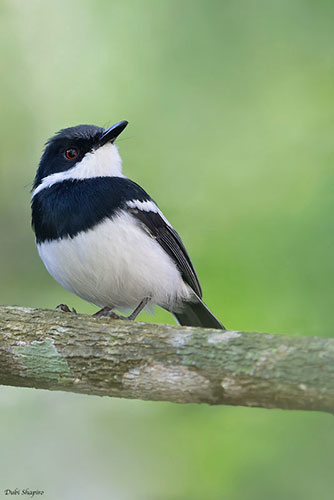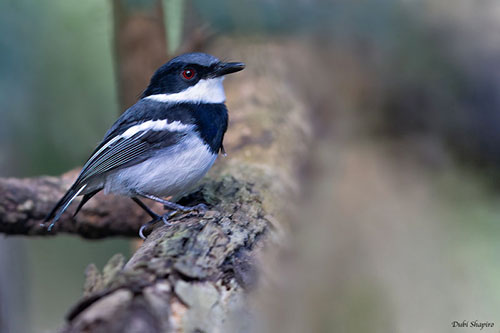
Fr: Pririt de Reichenow
Ang: Reichenow's Batis
All: Kurzschwanzschnäpper (Reichenowschnäpper)
Esp: Batis Colicorto (reichenowi)
Ita: Batis di Reichenow
Nd: Kortstaart-vliegenvanger (reichenowi)
Sd: reichenowbatis
Photographer:
Dubi Shapiro
Dubi Shapiro Photo Galleries
Text by Nicole Bouglouan
Sources:
HANDBOOK OF THE BIRDS OF THE WORLD Vol 11 by Josep del Hoyo, Andrew Elliott and David Christie - Lynx Edicions - ISBN: 849655306X
BIRDS OF AFRICA SOUTH OF THE SAHARA by Ian Sinclair and Peter Ryan - Princeton University Press Princeton and Oxford - ISBN: 0691118159
Fatbirder - The World’s Richest Information Resource about Birds for Birders
CREAGUS@Monterey Bay (Don Roberson)
Wikipedia, the free encyclopaedia
Home page
Page Order Passeriformes
Reichenow's Batis
Batis reichenowi
Passeriformes Order - Platysteiridae Family
INTRODUCTION:
The Reichenow's Batis is a very poorly known species endemic to the coastal lowland forest of SE Tanzania.
It was formerly treated as a subspecies of Cape Batis (B. capensis), or more often of Forest Batis or Short-tailed Batis (B.mixta). However, despite having some characteristics of both species, it is closer to B. mixta. But females are fairly different.
The Reichenow's Batis is treated here as a full species.
It is probably insectivorous like B. mixta. It lives in forest and second growth. It is territorial during the breeding season.
The Reichenow's Batis has very restricted range in which it is described as common. The species is not globally threatened, although some decline is suspected, caused by habitat loss.
The scientific name of this species pays tribute to the German ornithologist Anton Reichenow (1847-1941).

DESCRIPTION OF THE BIRD:
Biometrics:
Length: 9,5 – 10 cm
Weight: 10,5 – 14 g
The Reichenow's Batis is a small, short-tailed bird.
The male has grey forehead, crown, nape and mantle. The black wing feathers show pale grey edges, and we can see a conspicuous white wing stripe. This pattern forms a white V when the bird is seen from behind. The short tail is black with white tip, whereas the outer rectrices are edged white.
The underparts are white, contrasting with a black breastband.
On the head, a black mask extends from lores, around the eyes to ear-coverts. It is often bordered above by a narrow, white supercilium.
The bill is black. The eyes are deep red. Legs and feet are black.
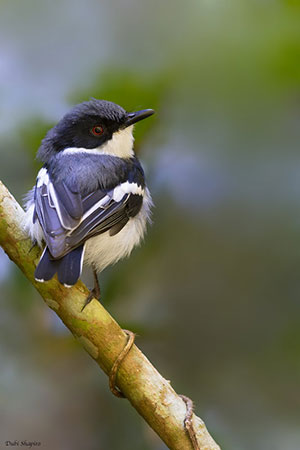
The female has dull grey breast and body sides, often tinged rufous on throat and some rusty on vent. The wing stripe is cinnamon.
On the head, the black mask is narrowly bordered above by a long, white supercilium.
The bill is black. The eyes are very dark. Legs and feet are grey.
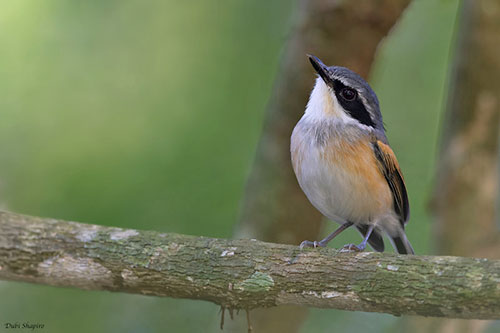
The immature has some olive wash on the back. Primaries and secondaries are edged rusty. On the breast, rusty is often mixed with grey.
RANGE:
The Reichenow's Batis is found in SE Tanzania (Mikindani and Lindi area), and possibly farther N near R Rufiji. It is suspected to be also found in adjacent NE Mozambique.
HABITAT:
The Reichenow's Batis is resident in coastal lowland forest and second growth.
CALLS AND SONGS: SOUNDS BY XENO-CANTO
The Reichenow's Batis gives a typical “chwerra-werra” call, very common in these birds. We can also hear a soft, two-note whistle.
BEHAVIOUR IN THE WILD:
The Reichenow's Batis is probably insectivorous like B. mixta. In this family, insects are the main part of the diet.
The commonest foraging behaviour includes foliage-gleaning, hovering and flycatching. This species forages at all levels in tree canopy, searching for insects such as termites. They are strictly arboreal.
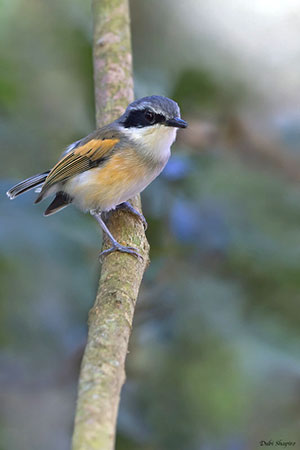
The Platysteiridae are territorial and monogamous during the breeding season.
Nothing is known about the Reichenow's Batis breeding behaviour. However, the courtship displays of these species frequently involve the fluffing-out of the rump feathers. Flight displays by both mates are reported and also noisy wing-flipping. Both mates bow and produce excited calls with bill-snapping.
The Reichenow's Batis is resident in its restricted range.
It is very agile in flight.
REPRODUCTION OF THIS SPECIES:
The following information comes from generalities about the Platysteiridae family. More studies are required for each species.
The breeding behaviour of the Reichenow's Batis is unknown. Generally, the birds of this family are territorial and monogamous. The nest structure is very uniform too.
These species build neat, small open cups that are not reused. They are usually made with stems and rootlets, but bark, moss and lichens are also added. These materials are tightly bound together and to the supporting branch with spider web. This structure is placed in tree fork or on horizontal tree branch. It is often exposed and sometimes at great height, up to 40 metres above the ground.
The female lays 1-3 eggs. The incubation period ranges from 17 to 18/19 days, and is manly undertaken by the female, with some help from the male during short periods.
The small chicks are fed by the female, but later, both parents feed them.
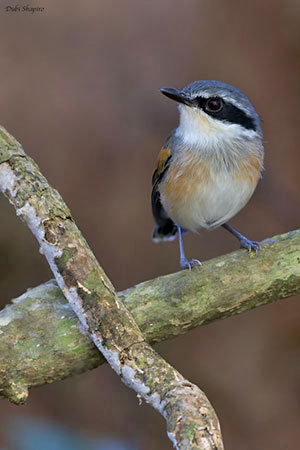
PROTECTION / THREATS / STATUS:
The Reichenow's Batis has very small range in which it is threatened by habitat clearance for agriculture expansion, involving the loss of the coastal forest in Tanzania.
The species is described as common, but the population is suspected to be declining.
But currently, the Reichenow's Batis is not globally threatened and the species is evaluated as Least Concern.
